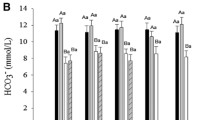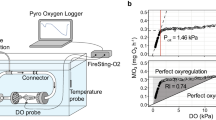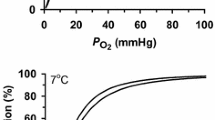Abstract
There are three Northeast Pacific Rivers still supporting spawning populations of green sturgeon, Acipenser medirostris, but all have been modified hydrologically and thermally by dam construction. Age 1- to 3-year-old green sturgeon, progeny of artificially spawned, wild-caught Klamath River adults, were used to assess the effects of temperature and carbon dioxide on critical hematological parameters related to evolutionary adaptations of this species to its physical environment. In vitro measurement of the effect of temperature and carbon dioxide on blood–oxygen affinity and equilibrium curve shape yielded the following data for the respective temperature treatments (11, 15, 19, and 24°C): half-saturation values (P50’s, kPa, a measure of affinity) 1.26, 1.44, 1.63, 1.69 for low-PCO2 treatments and 2.08, 2.41, 2.74, 2.94 for high-PCO2 treatments; Bohr factors −0.322, −0.327, −0.366, −0.536; and non-bicarbonate buffer values (slykes) −6, −3, −5, −8. Temperature sensitivities (ΔH, kJ mol O −12 ) between these respective temperatures were −34.20, −15.24, −6.74 for low-PCO2 treatments and −20.05, −27.00, and −11.55 for the high-PCO2 treatments. These data suggest that juvenile green sturgeon may tolerate moderate environmental hypoxia, moderate aerobic activity, low to moderate hypercapnia, and moderate temperature changes in their environments.
Similar content being viewed by others
References
Adams H (1963) Adensosine 5′-triphosphate determination with phosphoglycerate kinase. In: Bergmeyer HU (ed) Methods of enzymatic analysis. Academic Press, New York, pp 539–543
Adams SR, Parsons GR, Hoover JJ, Killgore KJ (1997) Observations of swimming ability in shovlenose sturgeon (Scaphirhynchus platornchus). J Freshwater Ecol 12(4):631–633
Adams SR, Adams GL (2003) Critical swimming speed and behavior of juvenile shovlenose sturgeon and pallid sturgeon. Trans Am Fish Soc 132:392–397
Allen PJ, Cech JJ Jr (2006) Age/size effects on juvenile green sturgeon (Acipenser medirostris) oxygen consumption, growth, and osmoregulation in saline environments. Environ Biol Fish (in press)
Allen PJ, Hodges B, Werner I, Cech JJ Jr (2006a) Effects of ontogeny, season, and temperature on the swimming performance of juvenile green sturgeon (Acipenser medirostris). Can J Fish Aquatic Sci (in press)
Allen PJ, Nicholl M, Cole S, Vlazny A, Cech JJ Jr (2006b) Growth of larval to juvenile green sturgeon in elevated temperature regimes. Trans Am Fish Soc 135:89–96
Birstein VJ (1993) Sturgeons and paddlefishes: threatened fishes in need of conservation. Conserv Biol 7:773–787
Boutilier RG, Heming TA, Iwama GK (1984) Physiochemical parameters for use in fish respiratory physiology. In: Hoar WS, Randall DJ (eds) Fish physiology, gills. Academic Press, New York, pp 403–430
Brett JR (1964) The respiratory metabolism and swimming performance of young sockeye salmon. J Fish Res Board Can 21:1183–1226
Brown K (2002) Spawning areas of green sturgeon, Acipenser medirostris, in the upper Sacramento River, California. U.S. Fish and Wildlife Service, Red Bluff, California
Burggren WW, Randall DJ (1978) Oxygen uptake and transport during hypoxic exposure in the sturgeon Acipenser transmontanus. Respir Physiol 34:171–183
Cameron JN (1971) Oxygen dissociation characteristics of the blood of the rainbow trout, Salmo gairdneri. Comp Biochem Physiol A 38:699–704
Cameron JN, Davis JC (1970) Gas exchange in rainbow trout (Salmo gairdneri) with varying oxygen capacity. J Fish Res Board Can 27:1069–1085
Campbell RR (1997) Rare and endangered fishes and marine mammals of Canada: COSEWIC fish and marine mammal subcommittee status reports: 11. Can Field Nat 111:249–257
Cech JJ Jr, Campagna CG, Mitchell SJ (1979) Respiratory responses of largemouth bass (Micropterus salmoides) to environmental changes in temperature and dissolved oxygen. Trans Am Fish Soc 108:166–171
Cech JJ Jr, Castleberry DT, Hopkins TE (1994) Temperature and CO2 effects on blood O2 equilibria in northern squawfish, Ptychocheilus oregonensis. Can J Fish Aquatic Sci 51:13–19
Cech JJ Jr, Laurs RM, Graham JB (1984) Temperature-induced changes in blood gas equilibria in the albacore, Thunnus alalunga, a warm-bodied tuna. J Exp Biol 109:21–34
Clementi ME, De Rosa MC, Bertonati C, Capo C, Cataldi E, Petruzzelli R, Giardina B (2001) Functional and structural properties of the hemoglobin components from Italian sturgeon (Acipenser naccarii). Fish Physiol Biochem 24:191–200
Crocker CE, Cech JJ Jr (1997) Effects of environmental hypoxia on oxygen consumption rate and swimming activiy in jevenile white sturgeon, Acipenser transmontanus, in relation to temperature and life intervals. Environ Biol Fish 50:338–389
Crocker CE, Cech JJ Jr (1998) Effects of hypercapnia on blood–gas, acid–base balance in white sturgeon, Acipenser transmontanus. J Comp Physiol B 168:50–60
Davenport HW (1974) The ABC of acid–base chemistry. The University of Chicago Press, Chicago, pp 39–41
Davis JC, Cameron JN (1971) Water flow and gas exchange at the gills of rainbow trout, Salmo gairdneri. J Fish Biol 54:1–18
Di Marco M, McKenzie DJ, Mandich A, Bronzi P, Cataldi E, Cataudella S (2000) Influence of sampling conditions on blood chemistry values of Adriatic sturgeon Acipenser naccarii. J Appl Ichthyol 15(4–5):73–77
Di Marco M, Mandich F, Mandich C (2001) Changes in serum cortisol, metabolites, osmotic pressure and electrolytes in response to different blood sampling procedures in cultured sea bass (Dicentrarchus labrax L.). J Appl Ichthyol 17(3):115–120
Dobson GP, Wood SC, Daxboeck C, Perry SF (1986) Intracellular buffering and oxygen transport in the Pacific blue marlin (Makaira nigricans): adaptations to high-speed swimming. Physiol Zool 59:150–156
Eddy FB (1971) Blood gas relationship in the rainbow trout, Salmo gairdneri. J Exp Biol 55:695–711
Edwards MJ, Martin RJ (1966) Mixing technique for the oxygen–hemoglobin equilibration Bohr effect. J Appl Physiol 21:1898–1902
Erickson DL, North JA, Hightower JE, Webe J, Lauck L (2002) Movement and habitat use of green sturgeon Acipenser medirostris in the Rogue River, Oregon, USA. J Appl Icthyol 18:565–569
Grigg GC (1974) Respiratory function of blood in fishes. In: Florkin N, Scheer BT (eds) Chemical zoology. Academic Press, NY, pp 331–368
Hall FG (1960) A tonometric apparatus for constant flow gas equilibration. J Appl Physiol 15:312–313
Hall FG, McCutcheon FH (1938) The affinity of hemoglobin for oxygen in marine fishes. J Cell Comp Physiol 11:205–212
Hinch SG, Rand PS (2000) Optimal swimming speeds and forward-assisted propulsion: energy-conserving behaviors of river-migrating adult salmon. Can J Fish Aquatic Sci 57:2470–2478
Houston AH (1990) Blood and circulation. In: Schrek CB, Moyle PB (eds) Methods for fish biology. American Fisheries Society, Bethesda, Maryland, pp 273–322
Jensen FB, Nikinmaa M, Weber RE (1993) Environmental pertubations of oxygen transport in teleost fishes: causes, consequences, and compensations. In: Rankins JC, Jensen FB (eds) Fish ecophysiology. Chapman and Hall, London, UK, pp 161–179
Kamshilov IM (2003) Environmental effects on the functional properties of hemoglobins of Acipenserids. J Icthyol 43(2):200–204
Lankford SE, Adams TE, Miller RA, Cech JJ Jr (2005) The cost of chronic stress: imapcts of a nonhabituating stress response on metabolic variables and swimming performance in sturgeon. Physiol Biochem Zool 78(4):599–609
Lomholdt JP, Johansen K (1979) Hypoxia acclimation in carp – how it affects O2 uptake, ventilation, and O2 extraction from water. Physiol Zool 52:38–49
Malte H, Weber RE (1987) The effect of shape and position of the oxygen equilibrium curve on extraction and ventilation requirement in fishes. Respir Physiol 70:221–228
Mayfield RB, Cech JJ Jr (2004) Temperature effects on green sturgeon bioenergetics. Trans Am Fish Soc 133:961–970
Moyle PB (2002) Inland fishes of California. University of California Press, Berkeley, p 502
Moyle PB, Foley PJ, Yoshiyama RM (1994) Status and biology of the green sturgeon. Acipenser medirostris. Sturgeon Quat 2:7
Nakamoto RJ, Kisanuki TT, Goldsmith GH (1995) Age and growth of Klamath River green sturgeon (Acipenser medirostris). US Fish and Wildlife Service, Arcata California
Powers DA (1980) Molecular ecology of teleost fish hemoglobins: strategies for adapting to changing environments. Am Zool 20:139–162
Powers DA (1983) Adaptation of erthyrocyte function during changes in environmental oxygen and temperature. In: Cossins AR, Sheterline P (eds) Cellular acclimatization to environmental change. Cambridge Press, Great Britain
Powers DA, Martin JP, Garlick RL, Fyhn HJ, Fyhn UEH (1979) The effect of temperature on the oxygen equilibria on fish hemoglobins in relation to environmental thermal variability. Comp Biochem Physiol 62A:87–94
Powers EB (1932) The relation of respiration of fishes to environment. Ecol Monogr II:387–473
Riggs A (1970) Properties of fish hemoglobins. In: Hoar WS, Randall DJ (eds) Fish physiology: the nervous system, circulation, and respiration. Academic Press, New York, NY
Root RW (1931) The respiratory function of the blood of marine fishes. Biol Bull 61:427–456
Schaffter RG, Kohlhorst DW (1999) Status of white sturgeon in the Sacramento-San Joaquin Estuary. California Fish Game 85:37–41
Scheid P, Meyer M (1978) Mixing technique for study of oxygen–hemoglobin equilibrium: a critical evaluation. J Appl Physiol Respir Eviron Exercise Physiol 45:818–822
Tucker VA (1967) Method for oxygen content and dissociation curves on microliter blood samples. J Appl Physiol 23:410–414
USFWS (1979) Klamath River fisheries investigations: progress, problems and prospects. Annual report. US Fish and Wildlife Service, Arcata, California, 49 pp
Van Eenennaam JP, Linares-Casenave J, Deng X, Doroshov SI (2005) Effect of incubation temperature on green sturgeon embryos, Acipenser medirostris. Environ Biol Fish 72:145–154
Van Eenennaam JP, Webb MAH, Deng X, Doroshov SI, Mayfield RB, Cech JJ Jr, Hillemeier DC, Wilson TE (2001) Artificial spawning and larval rearing of Klamath River green sturgeon. Trans Am Fish Soc 130:159–165
Weber DD, DeWilde JAM (1975) Oxygenation properties of haemoglobins from the flatfish plaice (Pleuronectes platessa) and flounder (Platichthys flesus). J Comp Physiol 128:127–137
Weber RE, Wells RMG (1989) Hemoglobin structure and function. In: Wood SC (ed) Comparative pulmonary physiology, current concepts. Dekker, New York, NY
Wood CM, McMahon BR, McDonald DG (1977) An analysis of changes in blood pH following exhausting activity in the starry flounder, Platichthys stellatus. J Exp Biol 69:173–185
Wood SC, Lenfant C (1979) Oxygen transport and oxygen delivery. In: Wood SC, Lenfant C (eds) Evolution of respiratory processes. Marcel Dekker Inc., NY
Wyman J (1964) Linked functions and reciprocal effects in hemoglobin: a second look. Adv Protein Chem 19:223–286
Acknowledgements
We thank the Yurok Tribal Council and fisheries biologists (especially, D. Hillemeier and M. Belchik) for broodstock; S.I. Doroshov, J.P. Van Eenennaam, and J. Linares-Casenave for broodstock spawning assitance; P. Lutes and E. Hallen for logistical support; J. Roessig, S. Nakamoto, T. Mussen, and C. Crocker for technical assitance; P. Allen and C. Woodley for useful discussions, and the comments of three reviewers for manuscript improvement. Financial support for this project was provided by the California Bay-Delta Authority ERP-02D-P57, Anadromous Fish Restoration Program (of the U.S. Fish and Wildlife Service and the U.S. Bureau of Reclamation, Agreement No. 11332-1-G005), CALFED (Agreement No. 99−F105), the UC Agricultural Experiment Station (Grant No. 3455−H) and a Fellowship co-sponsored by the Pharmacology and Toxicology Graduate Group and the John Muir Institute of the Environment, University California Davis.
Author information
Authors and Affiliations
Corresponding author
Rights and permissions
About this article
Cite this article
Kaufman, R.C., Houck, A.G. & Cech, J.J. Effects of temperature and carbon dioxide on green sturgeon blood–oxygen equilibria. Environ Biol Fish 76, 119–127 (2006). https://doi.org/10.1007/s10641-006-9014-7
Received:
Accepted:
Published:
Issue Date:
DOI: https://doi.org/10.1007/s10641-006-9014-7




